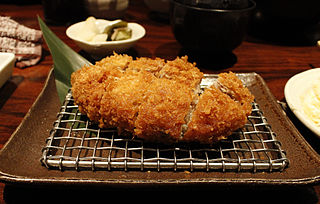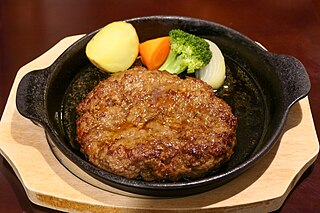Related Research Articles

Tonkatsu is a Japanese dish that consists of a breaded, deep-fried pork cutlet. It involves coating slices of pork with panko, and then frying them in oil. The two main types are fillet and loin. Tonkatsu is also the basis of other dishes such as katsukarē and katsudon.

Rocky Mountain oysters or mountain oysters, or meat balls, also known as prairie oysters in Canada, is a dish made of bull testicles. The organs are often deep-fried after being skinned, coated in flour, pepper and salt, and sometimes pounded flat. The dish is most often served as an appetizer.

Chateaubriand is a dish that traditionally consists of a large front cut fillet of tenderloin grilled between two lesser pieces of meat that are discarded after cooking. While the term originally referred to the preparation of the dish, Auguste Escoffier named the specific front cut of the tenderloin the Chateaubriand.

Demi-glace is a rich brown sauce in French cuisine used by itself or as a base for other sauces. The term comes from the French word glace, which, when used in reference to a sauce, means "icing" or "glaze." It is traditionally made by combining one part espagnole sauce and one part brown stock. The sauce is then reduced by half, strained of any leftover impurities, and finished with a sherry wine.

Sauce Robert is a brown mustard sauce and one of the small sauces, or compound sauces, derived from the classic French demi-glace, which in turn is derived from espagnole sauce, one of the five mother sauces in French cuisine.

Hayashi rice or hashed beef rice is a dish popular in Japan as a Western-style dish or yōshoku. It usually contains beef, onions, and button mushrooms, in a thick demi-glace sauce which often contains red wine and tomato sauce. This sauce is served atop or alongside steamed rice. The sauce is sometimes topped with a drizzle of fresh cream.

Steak sauce is a tangy sauce commonly served as a condiment for beef in the United States. Two of its major producers are British companies, and the sauce is similar to the "brown sauce" of British cuisine.

Omurice or omu-rice is a Japanese dish consisting of an omelette made with fried rice and thin, fried scrambled eggs, usually topped with ketchup. It is a popular dish also commonly cooked at home. Children in particular enjoy omurice. It is often featured in Japan's version of a children's meal, okosama-ranchi (お子様ランチ).

Bordelaise sauce is a classic French sauce named after the Bordeaux region of France, which is famous for its wine. The sauce is made with dry red wine, bone marrow, butter, shallots and sauce demi-glace. Sauce marchand de vin is a similar designation. Traditionally, bordelaise sauce is served with grilled beef or steak, though it can also be served with other meats that pair well with red wine demi-glace–based sauces.

A marron glacé is a confection, originating in northern Italy and southern France consisting of a chestnut candied in sugar syrup and glazed. Marrons glacés are an ingredient in many desserts and are also eaten on their own.

In cooking, a glaze is a glossy, translucent coating applied to the outer surface of a dish by dipping, dripping, or using a brush. Depending on its nature and intended effect, a glaze may be applied before or after cooking. It may be either sweet or savory ; typical glazes include brushed egg whites, some types of icing, and jam, and may or may not include butter, sugar, milk, oil, and fruit or fruit juice.

Hamburg steak is a patty of ground beef. Made popular worldwide by migrating Germans, it became a mainstream dish around the start of the 19th century. It is related to Salisbury steaks, which also use ground beef. It is considered the origin of the ubiquitous hamburger, when, in the early 20th century, vendors began selling the Hamburg steak as a sandwich between bread.

John Lawson Johnston was a Scottish entrepreneur and the creator of Bovril. He was born in 29 Main Street, Roslin, Midlothian. A memorial plaque is on the property and can be seen above the door. The plaque was put there by the Roslin Heritage Society.

Jason Charles "Jay" Glazer is a television personality and sports reporter. Since 2004, he has worked as an National Football League (NFL) insider for Fox Sports' NFL pregame studio show, FOX NFL Sunday, on which he reports exclusives, late-breaking updates, injury news, and other reports. The whole cast and their show were inducted into the TV Hall of Fame in 2019.
Sauce chasseur, sometimes called "hunter's sauce", is a simple or compound brown sauce used in French cuisine. It is typically made using demi-glace or espagnole sauce as a base, and often includes mushrooms and shallots. It may also include tomatoes and a finishing of fines herbes.

In classical French cuisine, a brown sauce is generally a sauce with a meat stock base, thickened by reduction and sometimes the addition of a browned roux, similar in some ways to but more involved than a gravy. The classic mother sauce example is espagnole sauce as well as its derivative demi-glace, though other varieties exist.

Sauce lyonnaise is a compound or small French sauce of demi-glace, white wine, vinegar and onions served with small cuts of meat principally for left-overs.

A stew is a combination of solid food ingredients that have been cooked in liquid and served in the resultant gravy. Ingredients can include any combination of vegetables and may include meat, especially tougher meats suitable for slow-cooking, such as beef, pork, venison, rabbit, lamb, poultry, sausages, and seafood. While water can be used as the stew-cooking liquid, stock is also common. A small amount of red wine or other alcohol is sometimes added for flavour. Seasoning and flavourings may also be added. Stews are typically cooked at a relatively low temperature, allowing flavours to mingle.

Chaudfroid sauce, also spelled as chaud-froid sauce, is a culinary sauce that can be prepared using a reduction of boiled meat carcasses and other ingredients. Simpler preparations of the sauce omit the use of meat, and some use sauces such as espagnole, allemande or velouté as a base. Chaudfroid sauce is typically served cold, atop cold meats and cold meat-based dishes such as galantine and terrine.